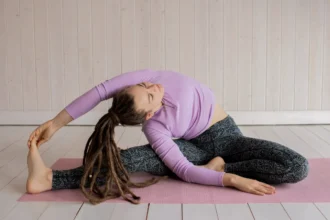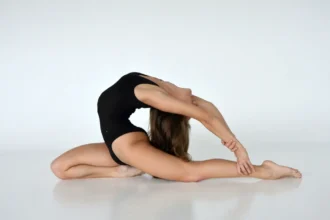A gymnastics pull-up is a specialized variation of the traditional pull-up, often used by gymnasts to enhance their upper body strength, grip, and overall athletic performance.
Here’s a detailed guide to mastering pull-ups in gymnastics:
Key Features of Gymnastics Pull-Ups
Unlike regular pull-ups, gymnastics pull-ups focus on maintaining a rigid body throughout the movement. This means engaging the core to prevent swinging and ensuring that the shoulders, elbows, and wrists are properly aligned.
- Shoulder and Scapular Engagement: Proper form involves retracting the shoulder blades down and back to engage the scapular muscles. This helps in stabilizing the shoulders and maximizing the engagement of the lats.
- Lat Engagement: Focus on pulling the elbows down towards the hips rather than simply pulling the chin over the bar. This ensures the lats are primarily engaged during the movement.
- Core Stability: Maintain a tight core to keep the body stable, reducing unnecessary movement and ensuring a smoother pull-up.
- Grip Strength: Incorporate hanging exercises and vary grip positions (overhand, underhand, neutral) to significantly improve grip strength, which is crucial for effective pull-ups.
Pull Up Routine for Gymnasts
Making a pull-up routine for gymnasts means using different pull-up variations to boost upper body strength, stamina, and muscle control. Here’s a sample routine with key pull-up techniques and progressions.
1. Standard Pull-Ups
Standard pull-ups are the foundation of upper body strength training. Use an overhand (pronated) grip, shoulder-width apart, and start from a dead hang with fully extended arms.
Pull yourself up until your chin is above the bar, focusing on maintaining strict form throughout the movement. Perform 3-5 sets of maximum repetitions to build strength and endurance.
2. Ring Pull-Ups
Ring pull-ups add an element of instability, engaging more muscles for stabilization. From a dead hang, pull yourself up until your chin is above the rings.
This variation is excellent for targeting stabilizer muscles in the shoulders, arms, and core. Aim for 3-4 sets of 8-12 reps.
3. Kipping Pull-Ups
Kipping pull-ups incorporate a dynamic swinging motion to generate momentum. Start with a kip swing, using your legs and hips to create a forward and backward motion.
At the peak of the backward swing, pull yourself up explosively. This technique builds power and endurance. Perform 3-4 sets of 10-15 reps.
4. Weighted Pull-Ups
Adding extra weight increases the resistance and intensity of the exercise. Use a weight belt, hold a dumbbell between your feet, or wear a weighted vest.
Focus on maintaining proper form while performing the pull-up. Start with 3 sets of 5-8 reps, gradually increasing the weight as you progress.
5. Assisted Pull-Ups
Assisted pull-ups are great for beginners or those looking to increase their pull-up numbers. Use a resistance band looped over the bar and under your feet or knees, or have a training partner support your legs.
This reduces the amount of body weight lifted, allowing you to focus on perfecting your form. Aim for 3-4 sets of 10-15 reps.
Weekly Training Plan
To incorporate these variations effectively, spread them out across the week to manage volume and allow for recovery:
Day 1:
- Warm-up with dynamic stretches and mobility exercises.
- Standard Pull-Ups: 3 sets to failure.
- Ring Pull-Ups: 3 sets of 8-12 reps.
- Assisted Pull-Ups: 3 sets of 10-15 reps.
Day 2:
- Weighted Pull-Ups: 3 sets of 5-8 reps.
- Kipping Pull-Ups: 3 sets of 10-15 reps.
- Core exercises: Planks, leg raises, and hollow holds.
Day 3:
- Active recovery with light cardio and stretching.
- Technique work: Practice form and grip variations.
Day 4:
- Repeat Day 1 or mix in other variations like wide grip, chin-ups, and L-sit pull-ups.
Day 5:
- High volume day: Perform multiple pull-up variations with shorter rest periods to build endurance.
Day 6-7:
- Rest or active recovery: Focus on mobility, flexibility, and light cardio.
Additional Tips
- Consistency: Regular practice is crucial. Incorporate pull-ups into your routine 2-3 times a week.
- Progression: Gradually increase difficulty by adding weight or attempting more challenging variations.
- Form: Focus on proper technique to maximize benefits and prevent injuries.
- Supplementary Exercises: Include lat pulldowns, single-arm rows, barbell rows, and bicep curls to build the necessary strength for pull-ups.
How Many Pull Ups Can Gymnasts Do?
The number of pull-ups a gymnast can perform varies widely based on their level of training and physical condition.
Average Gymnasts
- General Range: Most gymnasts can perform between 5 to 15 pull-ups depending on their fitness and training regimen.
- Progression Over Time: With consistent training, some gymnasts can increase their capability to perform up to 25 pull-ups in a single session.
Elite Gymnasts
- Higher Performance: Elite gymnasts, due to their rigorous training, often exceed 20 pull-ups, with some capable of performing up to 40-50 pull-ups.
- Muscle Ups: In addition to regular pull-ups, elite gymnasts often perform muscle-ups, which are a more complex combination of a pull-up and a dip, further showcasing their upper body strength.
Female Gymnasts
- Youth and Competitive Levels: Young competitive female gymnasts can typically perform 8-15 pull-ups in one set. With advanced training, this number can increase to 25 or more.
- Variations by Discipline: The specific discipline within gymnastics (e.g., artistic gymnastics vs. trampoline) can influence the number of pull-ups a female gymnast can perform due to different training focuses.
Chin-Up vs. Pull-Up: Key Differences in Gymnastics
In gymnastics, the distinction between a chin-up and a pull-up lies primarily in the grip used and the muscle groups targeted:
| Feature | Chin-Up | Pull-Up |
|---|---|---|
| Grip Orientation | Underhand (supinated) grip, palms facing towards the gymnast | Overhand (pronated) grip, palms facing away from the gymnast |
| Targeted Muscles | Biceps, lower trapezius, chest | Latissimus dorsi, upper trapezius, rhomboids, shoulders, forearms |
| Execution | Pull body up until chin is above the bar, lower in controlled manner | Pull body up until chin is above the bar, lower in controlled manner |
| Difficulty Level | Generally easier | Typically harder |
| Arm Position | Elbows stay closer to the body | Elbows flare out more |
| Muscle Emphasis | Strong involvement of biceps | Greater focus on back muscles |
Chin-Up
- Grip: Underhand grip (supinated), where the palms face towards you.
- Targeted Muscles: Chin-ups place more emphasis on the biceps and the lower part of the trapezius. They also engage the chest muscles more than pull-ups.
- Execution: Begin from a dead hang with arms fully extended. Pull your body up until your chin is above the bar, then lower yourself back down in a controlled manner. The narrower grip and palm orientation make it easier for many to engage the biceps effectively.
Pull-Up
- Grip: Overhand grip (pronated), where the palms face away from you.
- Targeted Muscles: Pull-ups primarily work the upper back muscles, such as the latissimus dorsi, as well as the upper trapezius and rhomboids. The forearms and shoulders also get a significant workout.
- Execution: Start from a dead hang with arms fully extended. Pull your body up until your chin is above the bar, then lower yourself back down slowly. The wider grip usually makes this exercise more challenging, as it reduces the involvement of the biceps and focuses more on the back muscles.
Conclusion
To dominate gymnastics pull-ups, it’s essential to understand the unique features and incorporate a well-structured routine focused on various pull-up techniques. With regular practice and gradual increases in difficulty, gymnasts can achieve impressive pull-up numbers.





